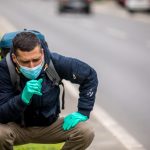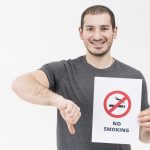COPD
COPD INTRODUCTION
Chronic obstructive pulmonary disease (often called “COPD”) is a lung disease that makes one short of breath. Chronic means long term disease that often gets worse over time and obstructive means limitation to the air in and out of the lungs due to narrowing of the airways due to swelling/inflammation. COPD is an umbrella term used to describe group of breathing disorders, most commonly chronic bronchitis (inflammation of the bronchial tubes) and emphysema (when the air sacs also become damaged. COPD is the 3rd leading cause of death and affects more than 50 million Indians (2016). It affects men and women older than 40 years of age. Even though COPD occurs more in men more women die of COPD. The rate of COPD continues to increase worldwide due to increase in smoking and air pollution.
COPD CAUSES
It is important to understand the normal functioning of the lungs to understand how COPD develops. As the air is inhaled, it travels down to the windpipe (trachea) and then the airways called bronchi. Inside the lungs the airways branch into smaller and smaller tubes called bronchioles, that are rich in blood supply. At the end of these tubes are billions of tiny air sacs called alveoli. Normally, the wall of the air sacs is elastic and flexible in nature. Inhalation causes each air sac to fill with air and exhalation causes each air sac to deflate. Efficient uptake of air into the lungs provides oxygen to the blood which then is carried to all parts of the body. In COPD, however the airways become thick and inflamed and they produce more mucus than usual. This mucus can clog the airways and makes it hard to breathe. In COPD, the walls of the air sacs in the lungs are damaged and loose their elastic qualities. The air sacs get floppy and broken and they lose their shape. As the air sacs get larger, the air gets trapped and there are fewer air sacs to supply oxygen to the blood and also it gets difficult for carbon dioxide to pass across the walls of the air sacs. Because air is trapped in air sacs, it is difficult for the lungs in patients with COPD to deflate like normal lungs and this makes harder to get fresh air into the lungs and make the breathing difficult.
The most common cause of COPD is swelling of the airways and damage of the air sacs caused by exposure to tobacco smoking- Bidi or cigarette. Long term exposure to second hand smoke, irritants like air pollution, dust or fumes at work place and biomass/wood smoke exposure also contribute to COPD. Uncommon genetic disorder like alpha1 antitrypsin deficiency is also associated with COPD.
COPD SYMPTOMS
The most common symptoms of COPD are long standing coughing and sputum production (mucus/Phlegm), shortness of breath on exertion and wheezing (a whistling noise when you breathe). As COPD progresses, symptoms worsen, breathing requires more energy and it may become harder to climb stairs and eventually harder to do even routine activities like bathing, getting dressed etc. People with COPD avoids activities due to breathlessness and feels tired and fatigued and thus they stop being active and slowly losses muscle and finally weight.
Symptoms get gradually worse as COPD progresses but some patients get sudden worsening of their symptoms which is called “exacerbations of COPD” or “Lung Attack”. In Lung Attack symptoms flare up more than usual and can last for several days and weeks. The cause of a COPD flare-up is usually a viral infection like flu or a bacterial infection. The lung attack can be serious and may cause hospitalisation and requires additional treatment for a few days or weeks to quickly relieve symptoms.
COPD DIAGNOSIS
Early diagnosis of COPD is essential for those at risk e.g. smokers. Once COPD is diagnosed, effective treatment can be started that can slow down or help prevent further damage from occurring in lung and thus prevent COPD from progression. Earlier the COPD is diagnosed better is the patient outcome. Patients with moderate to severe stage of COPD have greater risk to their health and worse outcomes than those diagnosed with mild stage of COPD. So, if you are a smoker and develops above symptoms of long-standing cough, sputum or shortness of breath then you should visit a pulmonologist who is COPD specialist to determine if your symptoms are due to COPD or not. You can search for COPD specialist doctor in your area or emphysema doctor near me. When the COPD doctor suspects that you might have COPD based on your history, he or she will ask you to visit nearby COPD clinic where you can have breathing tests, called pulmonary function tests (PFT)/spirometry. This test assesses how well your air is moving out of lungs and can predict COPD before symptoms are noticed or recognised. Spirometry test is simple, quick, painless and accurate and cost effective.
During PFT, the lung technician asks you to take a deep breath in and then exhale/blow as hard and as fast as you can into a tube connected to a machine called a spirometer. This test measures how much air you can exhale out of your lungs (forced expiratory volume, FVC) and how fast you can blow out in 1 sec (Forced expiratory volume in 1 sec, FEV1) and then compares your result against healthy individuals of similar age, height, gender and ethnicity. People with COPD blow air out more slowly because of swelling and narrowing of the airways. The test is repeated after you use a bronchodilator inhaler which helps to widen the airways. The measurements usually return to normal after using a bronchodilator inhaler in people with asthma, but in people with COPD, the measurements may only partially improve. In patients who already have COPD, spirometry is helpful to monitor changes in lung function especially if done a month or two after lung attack also know as COPD flare or acute exacerbation of COPD. Spirometry is repeated regularly to monitor your COPD and evaluate the response to treatments.
In some cases, COPD specialist will ask for additional pulmonary function tests. This might be help to rule out for other lung diseases that may be causing your symptoms and are confused with COPD eg heart failure, scarring of the lungs called lung fibrosis or asthma. Additional tests are usually done in special clinics (COPD speciality clinics in Delhi)
- Detailed Pulmonary function test with lung volume– The test measures the total volume of air in your lungs. In advanced COPD there is increase in the lung volume as the air gets trapped in lungs because of narrowed airways and damage to the air-sacs while in lung fibrosis the lung volumes are decreased.
- Detailed Pulmonary function test with diffusing capacity test- This test uses a very small amount of carbon monoxide and measures the capacity of the lungs to transfer gases like oxygen. In people with emphysema and lung fibrosis, the ability to transfer gases is typically reduced.
- Pulse oximetry – This test measures the saturation of oxygen in the blood, SPO2, using a small device which clips onto the finger called a finger pulse oximeter. Normally it is 98%. Oximetry is measured at rest, and during exercise, such as while you are walking or climb stairs. In advanced COPD and lung fibrosis the spo2 is usually low below 97% while in asthma spo2 is usually normal. Supplemental oxygen is usually prescribed when the oxygen saturation is 88 percent or below at rest.
- Arterial blood gas/Blood gas analysis – It measures partial pressure of gases oxygen and carbon dioxide in arterial blood. Arterial blood gas is obtained by taking a blood sample from the radial artery in your wrist.
- Exercise tests – eg six-minute walk test, which tests how far you can walk in 6 minutes.
- Alpha-1 antitrypsin levels — Alpha-1 antitrypsin deficiency is a genetic disorder causing 2 – 3 % of the cases of emphysema. Young adults who develops COPD should get alpha-1 antitrypsin levels done.
Imaging tests — a chest X-ray shows signs of COPD with hyperinflated lungs and in some COPD clinics in Delhi computed tomography (CT) scan is also ordered which can detect the presence of emphysema and help in selecting patients for advanced treatments of COPD like lung volume reduction surgeries. Sometimes CT scan is done for annual lung cancer screening using a special type of CT scan called Low dose CT scan.
COPD TREATMENT
The first and most important thing asked by doctors which you can do for COPD is to stop smoking or exposure to smoke. This is true important even you have advanced COPD as stopping smoking can slow progression of COPD. However, quitting smoking can be difficult, but your pulmonologist or a COPD doctor at special COPD clinic which provide quit tobacco treatment which can help you quit easily.
While there is no cure for COPD, you can take steps to feel better and stay more active and slow disease progression and improve quality of life, prevent lung attacks and hospitalisation. COPD can be managed by consulting a COPD doctor in your area or COPD specialist near you earlier than late and seeking diagnosis and intervention therapies, adopting life style changes that include quitting smoking, pulmonary rehabilitation and eating healthy diet and exercising and maintaining a positive outlook.
FAQ
Breathing difficulties and a persistent restriction in airflow are hallmarks of Chronic Obstructive Pulmonary Disease, or COPD. Emphysema and chronic bronchitis are usually its two main components.
COPD symptoms might include persistent coughing, copious mucus production, dyspnea (particularly during physical exertion), wheezing, tightness in the chest, exhaustion, and recurrent respiratory infections.
A patient's medical history, physical examination, lung function tests (spirometry), imaging tests (such as chest X-rays or CT scans), and occasionally blood tests to measure oxygen levels are used to diagnose COPD.
Yes, the diagnosis and treatment of COPD is a common area of specialization for pulmonologists, commonly referred to as lung experts. Furthermore, certain facilities might include multidisciplinary teams made up of pulmonologists, respiratory therapists, and other medical specialists, or even special COPD clinics.
You can search online directories of healthcare providers, ask your regular doctor for recommendations, or get in touch with hospitals or medical centers that have dedicated pulmonary departments to find COPD specialists in Delhi or your neighborhood.
Relieving symptoms, enhancing quality of life, and lowering the chance of worsening symptoms are the goals of COPD treatment. Inhaled or oral bronchodilator drugs, corticosteroids, oxygen therapy, pulmonary rehabilitation, and lifestyle changes (such quitting smoking and exercising) are among possible treatment choices.
For now, COPD has no known cure. Treatment, however, can help control symptoms, halt the spread of the illness, and enhance lung function and quality of life in general.
A COPD expert will review any prior diagnostic tests, perform a physical examination, take a detailed medical history, order any additional testing, or order imaging scans to evaluate lung function and identify the best course of treatment.
Yes, making lifestyle adjustments like giving up smoking, limiting exposure to irritants or pollutants in the environment, exercising frequently, maintaining a nutritious diet, and receiving all recommended vaccines can help control the symptoms of COPD and enhance lung health in general.
Make contact with local hospitals, medical facilities, or community health centers to locate COPD clinics or specialist pulmonary rehabilitation programs. You might also be able to find local COPD clinics or support groups by using online tools and directories.



